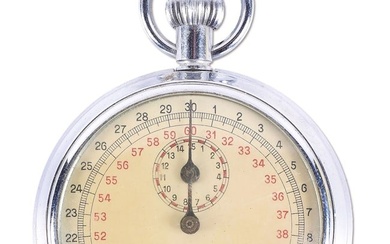German
A RARE GILT-METAL TWO-TRAIN CLOCK WATCH WITH STACKFREED AND HOG'S BRISTLE REGULATOR CIRCA 1590
• Movement: gilded full plate, verge escapement with iron wheel work, brass contrate wheel, steel dumb-bell foliot and hog's bristle regulator with arm connected to brass regulation dial, iron stackfreed cam and spring, iron count wheel, straight flat-edged gilded pillars with linear framed edges, striking a bell mounted to the inside case back
• Dial: gilded, Roman numerals with touch pins above, inner Arabic 24-hour ring, centre engraved with a stylised flower and surrounded by concentric circular engraving, steel single hand, the dial edge chamfered and engraved with repeated overlapping geometric motif
• Case: gilt-brass, the lid pierced and engraved with trefoil-shaped apertures and tracery-form centre, locking slide to the catch, case back with an urn to the base from which emanate a profusion of scrolling flowers and foliage all engraved and pierced for sound emission, convex case sides pierced and engraved with stylised scrolling foliage, ring pendant
diameter 70mm
Provenance:
In the 16th Century the main centres for watch making were Augsburg, Munich and Nuremburg and although not signed, the present watch is almost certainly from this region. Watches from this period were most commonly drum or tambour shaped and made of gilded brass.
The stackfreed, which was introduced in Germany, is used to equalise the force of the mainspring and consists of a cam geared to the arbor of the mainspring. Pressing against the cam is a roller mounted on a strong spring.
View it on
Sale price
Estimate
Time, Location
Auction House
A RARE GILT-METAL TWO-TRAIN CLOCK WATCH WITH STACKFREED AND HOG'S BRISTLE REGULATOR CIRCA 1590
• Movement: gilded full plate, verge escapement with iron wheel work, brass contrate wheel, steel dumb-bell foliot and hog's bristle regulator with arm connected to brass regulation dial, iron stackfreed cam and spring, iron count wheel, straight flat-edged gilded pillars with linear framed edges, striking a bell mounted to the inside case back
• Dial: gilded, Roman numerals with touch pins above, inner Arabic 24-hour ring, centre engraved with a stylised flower and surrounded by concentric circular engraving, steel single hand, the dial edge chamfered and engraved with repeated overlapping geometric motif
• Case: gilt-brass, the lid pierced and engraved with trefoil-shaped apertures and tracery-form centre, locking slide to the catch, case back with an urn to the base from which emanate a profusion of scrolling flowers and foliage all engraved and pierced for sound emission, convex case sides pierced and engraved with stylised scrolling foliage, ring pendant
diameter 70mm
Provenance:
In the 16th Century the main centres for watch making were Augsburg, Munich and Nuremburg and although not signed, the present watch is almost certainly from this region. Watches from this period were most commonly drum or tambour shaped and made of gilded brass.
The stackfreed, which was introduced in Germany, is used to equalise the force of the mainspring and consists of a cam geared to the arbor of the mainspring. Pressing against the cam is a roller mounted on a strong spring.







